All-New Yamaha Nytro for 2008

Is 130 Horsepower, Outstanding Ergonomics Enough?
One area where Yamaha knew it hasn’t been competitive is in the snocross-style, ‘big bump’ category of performance snowmobiling. Enter the all-new, 1050cc, three-cylinder, four-stroke Nytro. The name ‘Nytro’ may remain from the past, but this is much more than bolder, newer graphics.
Engine Type:Horizontal In-line
Cylinders:3
Engine Stroke:4-Stroke
Valve Configuration:DOHC
Displacement:1049 / 64
Starter:Electric
Turbocharged:No
View Full SpecWith an all-new fuel injected triple that classifies for snocross racing classes, the Nytro is the lightest full-size 4stroke performance sled Yamaha has created to date. On its website, Yamaha is leaving the weight issue unspecified.
In chats with Yamaha officials at a pre-introduction press briefing back in January, we were led to believe that a trail ready, wet weight Nytro RTX with electric start and reverse would come in around 560 pounds, about 20 pounds lighter than a 2007 Ski-Doo Blizzard 600. The base Nytro RTX sans reverse would be 10 to 12 pounds lighter. Unfortunately, with Ski-Doo’s unveiling of its newest REV-like sports sled reportedly coming in with dry weights mimicking Yamaha’s twin-cylinder Phazer, Nytro isn’t the lightest big bumpster. However, it still should be the lightest 4stroke big bump sled.
Going after the known market and anticipating that others might lighten their sleds, Yamaha built the Nytro with power-to-weight in mind. If we did our math right, with its 1050cc triple and claimed 130 horsepower, the new Nytro’s performance should rival that of the more powerful and heavier Apex 150-hp engined Yamahas.
Nytro’s triple is said to be based on the Vector, but we take that to mean that it resembles the 120-hp Vector triple in the same way the Apex four-cylinder engine resembles the RX-1 engine that it replaced. If so, all the resemblance means is that both have three cylinders and no gear reduction. Not much else is the same—as the fuel injected Nytro triple is said to be 11 pounds lighter than the carbed Vector motor!
First 4Stroke SX Win
This engine (and chassis) is essentially the same product design that won the Brainerd, Minn. snocross and became the first-ever 4stroke to do so. Imagine Yamaha’s delight. While the R&D Yamaha snocrossers have evolved, so has the competition and Yamaha, while placing well, has not had another victory as we write this piece.
We can verify Yamaha’s claim that the Nytro offers an exceptionally strong 96 pounds-feet of torque from 5000 to 6000 revs. It is a grip ripper when you slam the throttle forward. Yamaha claims that the new engine delivers 95 percent of its peak power at 1200 rpm.
We also noticed that Yamaha must have felt that Arctic Cat was on to something when it made its new Jaguar 4stroke free rolling and eliminated the potential for engine braking that has been a trademark feature of the Yamaha 4strokes. The Nytro free wheels when you let off the brake. Veteran Yamaha 4stroke riders will notice this right away and have to get used to it all over again. But for riders coming off 2stroke brands, the Nytro power delivery will feel familiar.
Couple, Uncouple
Now, because these were prototype Nytros and because Yamaha was trying to impress us with power and torque, we aren’t certain that all actual production Nytros will react as our test units did. When we grabbed a handful of throttle we were instantly shot rearward on the saddle as the skis leapt off the snow. Is that how the real Nytro is? Or, is it how Yamaha wants us to perceive the Nytro’s holeshot performance? If it is actual, we question it. It would seem to indicate a lack of suspension coupling on the under track rear suspension system. As we are big believers in coupled suspensions, we are not fans of the Nytro’s initial full throttle reaction.
Coming from a more conservative school of performance, we like our contact points to actually be in contact with the terrain more often than not. When we auto-slalomed our sporty cars, we insisted on having all four of our tires as flat and biting on the asphalt as possible. We like having our motorcycle’s tires contacting the asphalt when we corner. Even if there are only three main points of contact on a snowmobile, we like to have them in contact with the terrain. Considering that one point of contact—the track—can totally overwhelm the remaining two points of contact—the ski blades—you might see why we like the skis on the ground when we ride.
We have ridden other sleds with a tendency to porpoise the front end under hard acceleration and found it more exciting than necessary. Example, you are coming into a turn, brake hard, hit the corner correctly and expect the ski bite to guide you around the turn as you apply throttle. Hit the throttle with enthusiasm and get ski lift and you may be saying ‘Howdy Do!’ to the brush. It’s an inconsistency that fully coupled suspensions don’t generally have. So, we disagree with the suspension setup on the Nytro units that we tested.
We also think that Yamaha—and others—listen too closely to their snocross advisors and not enough to their hard-riding consumers. If you have rear or front suspension with extra long travel shock pistons capable of reducing big moguls to molehills, shouldn’t you exercise it fully? The modern big bump suspension seems to have no travel in it at all. Hey, I’ve ridden bogie wheeled sleds. I’ve raced cross-country for hundreds of miles on slide rail suspensions that were lucky to have an effective three inches of travel. Why on earth, would I—or should any performance rider—be left with a long travel bump suspension that has the ride characteristics of the racers of old? No way!
Compromises
Yamaha’s Nytro, like many big bump sleds, compromises its suspensions. These sleds are designed to ride straight ahead, hit big bumps head-on, fly through the air and land hard. Works great in snocross. For the real world of on-trail big bumps, the moguls are off-camber, not spaced to be taken five at a time so you can do a mid-air, heel-clicker, and usually not seen until the last second. What this requires is a stable suspension setup with terrific weight transfer from side to side and end-to-end. The front suspension has to be fully capable of soaking up the initial steering shock without ripping the handlebar from the rider’s grip. The skis have to shift weight from side to side as most moguls are higher or lower from side to side. Then the rear suspension’s front shock has to collapse along the length of its shock rod smartly enough to telegraph its reaction through the assisting coil spring to the rearmost suspension shock. You want this all to happen without fully bottoming either suspension. And you do not want to get a spine-banging jolt when you first hit the bump or when you land. When you land you want to get all three contacts quickly on the snow so you can steer to position the sled for the next obstacle.
My personal opinion is that the Nytro is a bit wanting in the big bumps. The front suspension needs to be more responsive from side-to-side and the rear suspension needs to be smoother and absorb more of the big bump without any aftershock from the coil spring. My guess is that this is not what the snocross advisors are telling the engineers, because they are standing up and they want stiff response over a snocross course, which is correct for them. Not for the world of high mileage, high performance ditch riding.
Ergos Great
Now, then we must compliment Yamaha for the ergonomics of the Nytro. Ergos are truly outstanding. You can stand up comfortably and in control. We bet mountain riders will like the deep snow versions of this sled for its rider friendly cockpit. The sled’s cowling has been rounded off to allow ample side-to-side movement for cornering and the wide footboards accommodate stand up riding exceptionally well. You can readily move around on this sled. The seat was comfy without being overly soft but not rock hard as the Polaris Dragon saddle. Overall the reach for controls was very good.
Yamaha has worked hard on its gauge package, with a nice big speedometer reading in your face. We’ve come around that nearly infinite handlebar heater settings are unnecessary and fiddling with the heater controls is a bit of a pain on the trail. We like the quick slide of a switch at either bar end for handwarmer or thumbwarmer. Unless the control icons are going to be in color, why not just go with a simple mechanical sight gas gauge or a warning beep when low on fuel?
And, for heaven’s sake, if the gauges are computerized, can’t Yamaha calculate well enough to create real speeds and not those overly optimistic renderings we’ve seen since those 122-mph speedometers of a few years back? Yamaha speedometers are easily 10 percent off the mark on most of its sleds. The Phazer really hits 87mph?
Pro And Con
Styling-wise, the Nytro is a winner. We really like the precision of the Mikuni throttle bodied fuel injection. And we like the fact that Yamaha 4strokes are hearty sounding, strong pulling and quick to rev. And we like the fact that Yamaha has made such a serious commitment to the sport with 4strokes.
We think the Nytro is going to find the competition wasn’t wasting time. If the Phazer can serve as an example, the Nytro will be lighter than most full-sized 4stroke-powered sleds, but by full production it will have added weight and is going to come in heavier than most of its 2stroke competitors. Its 130 ponies will be necessary to make its 4stroke triple equivalent to most of the competition’s 600cc 2stroke twins.
Yamaha has done a nice job with the Nytro and we think it will draw some riders off other brands, but the serious, not loyal to brand, extreme rider will look at weight, power, ergonomics and race wins when he makes his decision to buy. Will it be the Nytro?



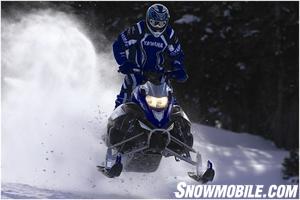
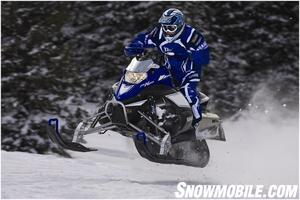
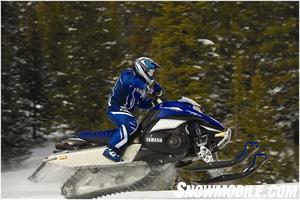
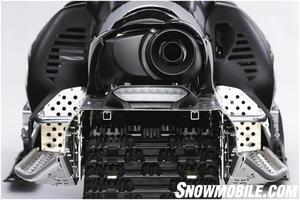
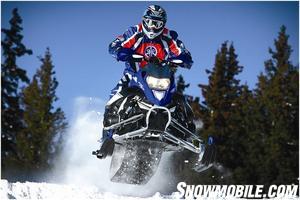
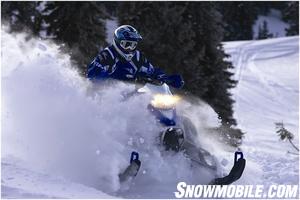


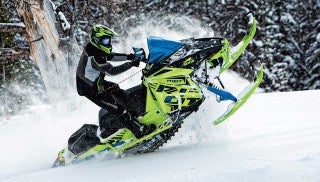


 Your Privacy Choices
Your Privacy Choices